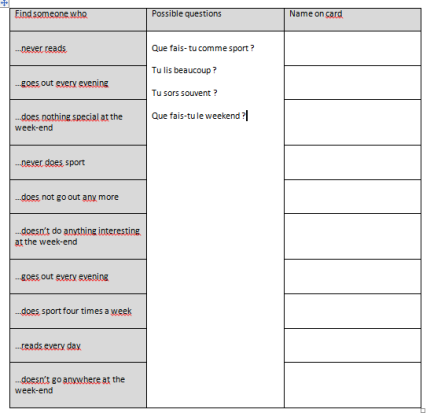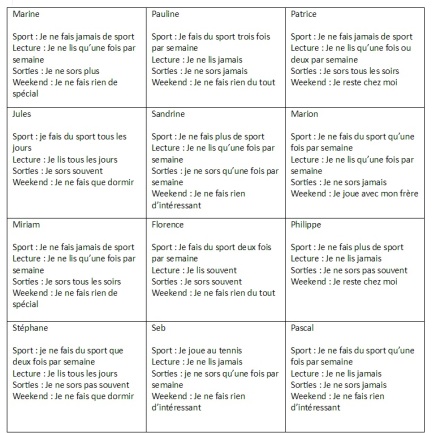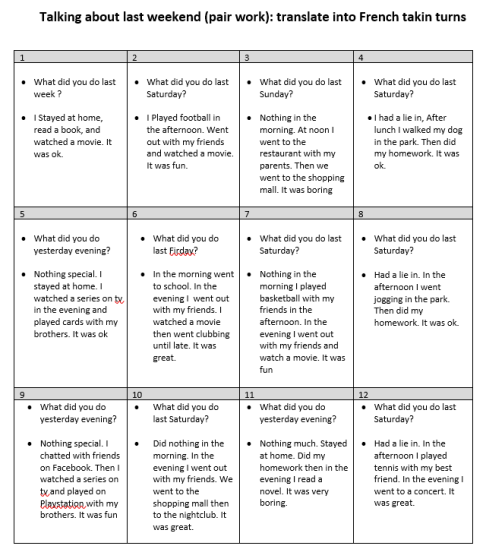The year just gone was one of the best I have ever had in terms of professional development as a teacher, researcher, writer and CPD provider. In this blog I share ten things that I have tried out in 2016 that, in my view, have significantly enhanced teaching and learning in my lessons.
1.Doubled the exposure to receptive processing and delayed production
One major change to my teaching has involved massively increasing my students’ exposure to comprehensible input before engaging them in production. Thus, on introducing a new phoneme, grammar structure, communicative function and/or vocabulary set, I now ensure my students process the target items receptively through as wide as possible a range of listening and reading tasks which recycle them to death (narrow reading being one of my favourite reading/listening tasks).
In order to enable my students to learn from the aural and written input provided, as illustrated in the texts in figure 1, I make sure it contains lots of patterned repetitions, cognates and familiar language and contextual clues which facilitate inference (so that 95 % would be accessible without resorting to guessing or dictionaries). I also usually provide a gloss in the margin and use typographic devices to draw their attention to items I want them to notice.
Figure 1 – narrow reading texts including comprehensible input with lots of patterned repetitions and cognates

I found that massively increasing receptive processing and delaying production – often to the second lesson on a new topic – has greatly benefitted my students, both in terms of confidence and understanding of the target items, especially when the tasks carried out on the aural and written texts involve lots of pattern recognition (see point 2), recycling and, most importantly, modelling. It is important to reiterate again the distinction between reading and listening aimed at modelling and reading and listening aimed at quizzing (i.e. the typical listening/reading comprehension). In my approach, listening and reading comprehension tasks are staged only at the end of the whole process.
2.Grammar and pattern recognition through listening
The extensive research I have carried out this year has made me aware of a gap in traditional explicit grammar instruction methodology: grammar is rarely taught regularly and systematically through listening and very few – if any – published materials purporting to do that exist. In my instructional model (MARS), exemplified in this post, grammar instruction nearly always begins with modelling of target grammar use through a L.A.M. (Listening-As-Modelling ) activity such as a sentence-builders, sentence puzzles or cognitive comparison tasks.
Figure 2. Sentence puzzles

This approach to grammar instruction addresses two important skillsets involved in listening comprehension, i.e.: decoding and parsing skills. As I detailed in one of my most widely read posts. ‘Teaching grammar through listening’, the latter skillset is paramount in the Parsing phase of comprehension, when Working Memory attempts to interpret what it hears using the grammar of the language (by fitting the words identified to the surrounding linguistic context).
3.Inductive Grammar teaching
The adoption of the approach touched upon in the previous paragraph has led me to abandon deductive grammar teaching and the traditional PPP sequence (Presentation, Practice, Production). Unless I am pressed for time, I now involve the students in problem solving activities which requires them to figure out the target grammar rule(s) by themselves based on the Listening-as-Modelling activities staged. Example: I may start with a sentence puzzle modelling how the negatives are used in French; after many examples, I would ask the students, working in groups of two or three, to work out the rule and explain it on a google document or padlet wall shared with me and the rest of the class.
After this student-led discovery phase, intensive receptive processing practice will ensue through listening and reading tasks (e.g. narrow reading), grammar quizzes and puzzles, and oral interaction (find your match or find someone who with cards). Since in my approach automatizing grammar is the main purpose of grammar instruction, this receptive phase is followed by structured oral practice – see next paragraph.
Figure 3 – Find-someone-who with cards. Grid to fill in (above) and Cards (below)


4. Communicative oral drills and closed questions
In the past year I perfected and intensified the use of CDs and closed questions in an attempt to routinize the target grammar structures and vocabulary.
4.1. Communicative drills (CDs)
Communicative drills, as the figure below show, are very short and highly structured tasks which ‘force’ the students to deploy the target items as many times as you feel fit, over and over again, in the context of real-life-like situations. Unlike audiolingual drills, CDs typically include lexical items (words and chunks) of high surrender value (e.g. high frequency words or formulaic language) which are very useful in real life communication and are contextualised in the topic-at-hand.
In the teaching sequence I typically use in my lessons, M.A.R.S. (Modelling, Awareness-Raising, Receptive processing, Structured production), CDs occur in the end-phase, after lots of receptive processing as occurred which exposed the students frequently to the same language included in the CDs. I usually stage three or four different types of CDs per session.
Figure 4. 2 type of Communicative Drills I use in my lessons. Translation into French (above) and Illustrated cards game in the past tense (below)

4.2 Closed questions
I have also massively increased the amount of closed questions I ask my students as, unlike some language teaching ‘gurus’ advocate, I believe that closed questions – not open questions- are key to the development of spontaneity. By the way, by ‘closed questions’ I do not simply mean ‘true or false’ or ‘Yes or No’ questions, but also questions such as ‘What is your name?’, ‘What sport do you like?’, ‘What did you do last weekend?’ – as opposed to open questions such as ‘Talk to me about yourself’.
But, why more closed questions? Firstly, because by prioritising open questions students are not pushed to diversify their vocabulary. Secondly, they do not learn much vocabulary from the questions themselves (and questions are powerful modellers of new language). Thirdy, because ‘spontaneous speakers’ are first and foremost ‘spontaneous comprehenders’. The comprehension dimension of ‘oral spontaneity’ is often neglected, although is by all accounts as important as the production dimension.
Imagine asking the open question ‘What do you do in your free time?’ the student can get away with the usual ‘I play football and go to the cinema’. However, asking students a wider range of closed questions such as ‘What sport do you do?’, ‘What tv shows do you watch?’, ‘What movies do you watch?’, ‘What social media do you use?’, ‘What do you read?’, ‘What music do you listen to?’ allows you to tap into specific areas of their vocabulary and grammar knowledge, as well as developing their Listenership. Students who are asked a lot of closed questions get constant stimulation thereby learning more language both receptively – as they decode the questions – and productively, as they retrieve the specific vocabulary needed to answer (I usually ask them to pack at least three details in each answer, however close the questions is).
Both the intensive communicative oral drilling and the use of closed questions have greatly enhanced my grammar teaching whilst allowing me to recycle old and new vocabulary.
5.Hyper-questioning and Listenership
Not only have I increased the amount of closed questions I ask in class, but I have actually made a conscious and systematic effort in every single lesson to ask more questions overall, both open, closed and yes/no or true/false ones. This has entailed:
(1) More modelling of new language in the presentation stage through questioning techniques such as ‘Either / or’ (e.g. pointing at a picture on screen: ‘Is he doing ‘X’ or ‘Y’?) Substitution, etc.;
(2) Work on increasing speed of student response to questions;
(3) Learning about question formation through modelling (e.g. question puzzles) and explicit grammar study (e.g. studying word order and hyphenation in French questions);
(4) Reading comprehension tasks which involve understanding of questions rather than statements set;
(5) Widening the questions repertoire I expose the students to;
(6) Designing oral tasks and assessments which lay more emphasis on asking questions.
Why? In order to develop the area of oral spontaneity that is usually less focused on by teachers: ‘spontaneous comprehension’ or ‘Listenership’ as it is known amongst Applied Linguists.
A regular zero-preparation activity that I have staged regularly in lessons has involved asking questions to my students who, equipped with mini-boards, respond in writing under time constraints. Another frequent minimal preparation starter or plenary has consisted of giving my students a statement and asking them to write on mini whiteboards a possible question that statement could be the answer to.
6.My recycling tool
Last year I also created a simple recycling tool (in the figure below) that has allowed me to recycle the core grammar items more systematically over the whole school year. It consists of a spreadsheet on which I keep track of how often I practise a given grammar structure. In selecting the items on the tracking sheet and assigning them a priority I have used another strategy, discussed in the next paragraph.

7.Error-informed curriculum design and delivery
Irritated by the disproportionate emphasis lain by English schools on very time-consuming and largely ineffective dialogic corrective practices (e.g. students respond to feedback and teacher respond to student response, etc.), last year I decided to tackle learner errors from three different angles.
Firstly, as discussed in paragraph 1, by delaying production in order to pre-empt errors stemming from unfamiliarity with the target structure (as errors are often made by rushing production); secondly, as discussed in paragraph 4, by engaging students in as many structured tasks as possible before venturing in less structured ones; thirdly, by monitoring my students’ mistakes, keeping a tally of their most frequent ones and using my findings to inform my teaching.
So, whenever I went through their books or recordings or listened in as they interacted with one another during oral activities, I noted down day in day out on a google doc their more common and serious mistakes and modified my schemes of work accordingly making sure that I would tackle those issues in the lessons to come. It was not very time consuming; it reduced the time I spent writing in their books (as I was going to deal with them in class anyway) and has made me become a better observer and listener of my students’ output.
8.The 4,3,2 technique
This technique consists of getting a student to answer the same open question (e.g. ‘What did you do last weekend) three times. At time one you will ask them to answer the question in two minutes; at time two, in one minute and a half (i.e. 3/4 of the time employed at time 1); at time three in one minute. This technique, which I reserve to discuss in a forthcoming post, has been proven to significantly enhance L2 learner oral fluency not only within the topic in which the students use the technique but in terms of overall speaking spontaneity and proficiency.
Although I have been using it with my GCSE students only for three months, it has already paid good dividends. The rationale for its success is that it helps the students – after much practice – to automatize sub-routines thereby speeding up Working Memory processing.
9. Experiments with pronunciation of problematic French endings
As part of my on-going research on decoding-skill instruction in the last part of 2016 I endeavoured to enhance my year 8 students’ ability to pronounce French word endings; more specifically I worked on the pronunciation of silent word endings (e.g. ‘s’, ‘t’, ‘e’) in French using the Micro-Listening Enhancers detailed in this PPT (put together with my colleague Dylan Vinales for a conference we delivered recently). After a baseline assessment in which identified the problematic endings I carried out instruction as follows : 10 minutes session per lesson, contextualizing the decoding-skill work within the teaching of the vocabulary-at-hand. After a whole term of such instruction, the students’ ability to pronounce the endings which were problematic at pre-test increased by an average of 70 %, with 2 of the 17 students in the class making only a couple of mistakes.
10.‘Spot the intruder’ and ‘Spot the error’ listening tasks
These tasks have been regular features in my lessons for the last nine months or so. They focus students on listening for detail like nothing else, thereby developing their bottom-up processing skills. They require very little preparation, all one has to do is doctor the lyrics of a target language song by inserting a few extra words here and there (usually small ones) or errors; students then listen to the song tasked with identifying the items planted in the text. Here is an example by Dylan Vinales which cleverly combines a number of my micro-listening enhancers including ‘Spot the intruder’ and ‘Spot the mistake’. Here is a video of Dylan and Ronan Jezequel rehearsing the song the tasks are based on in one of our classrooms at Garden International School.
To find out about my ideas on reading instruction, get hold of ‘The Language Teacher Toolkit’, the book Steve Smith and I co-authored .

Many of these strategies/activities/things assume students are at roughly a similar level linguistically/academically/age. Do you have any things for very diverse classes of language learners?
LikeLike
I actually use much of the above across all the ability spectrum. Being a secondary school teacher I mostly work with 11 to 16 year olds, though.
LikeLike
I work with the same age group but with very multi-levelled classes. I have raw beginners, background speakers, heritage speakers, continuers from primary school, bilingual speakers of another language… And then there’s the motivated and unmotivated, those who have good study habits, those who do not… It’s crazy, but crazy fun. There’s different courses for them when they get to upper school but not in middle school. This makes planning difficult because the background and heritage speakers need extending so that they are successful in their US courses while others are learning to say “Hello”.
LikeLike
Great post! Love the idea of the grammar spreadsheet
LikeLiked by 1 person
So much of this sounds so simple, but to put it into deliberate practise is well thought out albeit time-consuming. You really do your pupils a service. Some excellent ideas for the new GCSE to build confidence and spontaneity. Unfortunately pupil response is here to stay in UK schools at the moment. I like to use it as a chance for self-reflection by starting the response with a question.
LikeLiked by 1 person
Thank you Sarah. Time consuming but rewarding. 🙂 Thanks for dropping by.
LikeLike
“Autrefois”, dans la bouche d’un ado qui parle de sa propre expérience, ça fait un peu bizarre, mais pour le reste, tout plein de bonnes idées, merci !
LikeLiked by 1 person
Ado? Pas moi…Viellard, c’est plutôt le mot juste
LikeLike
[…] this time I started reading blogs by practitioners like Ross Morrison McGill, José Picardo and Gianfranco Conti, which I cannot recommend highly […]
LikeLike
you know number 8, do you do this back to back, or do you do it across the course of a lesson?
LikeLiked by 1 person
Back to back
LikeLike